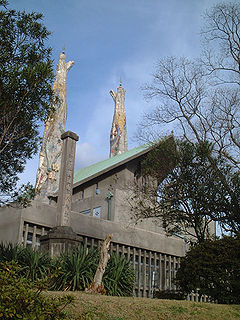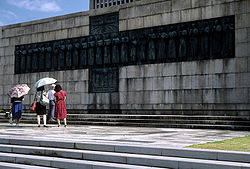
Twenty-Six Martyrs Museum and Monument
Encyclopedia

Canonization
Canonization is the act by which a Christian church declares a deceased person to be a saint, upon which declaration the person is included in the canon, or list, of recognized saints. Originally, individuals were recognized as saints without any formal process...
of the Christians executed on the site on February 5, 1597. The 26 people, a mixture of native Japanese Christians and European priests (20 Japanese, four Spaniards, one Mexican and one Indian) had been arrested in Kyoto
Kyoto
is a city in the central part of the island of Honshū, Japan. It has a population close to 1.5 million. Formerly the imperial capital of Japan, it is now the capital of Kyoto Prefecture, as well as a major part of the Osaka-Kobe-Kyoto metropolitan area.-History:...
and Osaka
Osaka
is a city in the Kansai region of Japan's main island of Honshu, a designated city under the Local Autonomy Law, the capital city of Osaka Prefecture and also the biggest part of Keihanshin area, which is represented by three major cities of Japan, Kyoto, Osaka and Kobe...
on the order of Toyotomi Hideyoshi
Toyotomi Hideyoshi
was a daimyo warrior, general and politician of the Sengoku period. He unified the political factions of Japan. He succeeded his former liege lord, Oda Nobunaga, and brought an end to the Sengoku period. The period of his rule is often called the Momoyama period, named after Hideyoshi's castle...
, the national ruler, for preaching Christianity
Christianity
Christianity is a monotheistic religion based on the life and teachings of Jesus as presented in canonical gospels and other New Testament writings...
. They were imprisoned, then later marched through the snow to Nagasaki, so that their execution might serve as a deterrent to Nagasaki's large Christian population. Hung up on 26 cross
Cross
A cross is a geometrical figure consisting of two lines or bars perpendicular to each other, dividing one or two of the lines in half. The lines usually run vertically and horizontally; if they run obliquely, the design is technically termed a saltire, although the arms of a saltire need not meet...
es with chains and ropes, the Christians were lanced to death in front of a large crowd on Nishizaka Hill. St Paul Miki is said to have preached to the crowd from his cross.
The main theme inherent in the both the museum and monument is "The Way to Nagasaki" - symbolising not only the physical trek to Nagasaki but also the Christian spirit of the martyr
Martyr
A martyr is somebody who suffers persecution and death for refusing to renounce, or accept, a belief or cause, usually religious.-Meaning:...
s. The museum's collection includes important historical articles from both Japan and Europe (such as original letters from the Jesuit priest St Francis Xavier) as well as modern artistic works on the early Christian period in Japan. The displays are arranged chronologically into three periods: the early Christian propagation, the martyrdoms, and the persistence of Christianity underground during the persecution.

Fumie
A was a likeness of Jesus or Mary upon which the religious authorities of the Tokugawa shogunate of Japan required suspected Christians to step in order to prove that they were not members of that outlawed religion. The use of fumi-e began with the persecution of Christians in Nagasaki in 1629...
" or treading images. Every year from 1629 to 1857, Nagasaki residents were forced to go through a ritual of stepping on bronze images of Christ
Christ
Christ is the English term for the Greek meaning "the anointed one". It is a translation of the Hebrew , usually transliterated into English as Messiah or Mashiach...
or Mary to prove they were not Christians. Also to be seen are statues of the Virgin Mary in the guise of Buddhist deities such as Miroku
Miroku
Miroku may refer to:* Japanese for "Maitreya Buddha": as prophesied by the Buddha before entering nirvana.* Miroku, the character in the anime and manga series InuYasha.* Miroku Corp., a gun manufacturer....
and Kwannon Bodhisattva to which the hidden Christians
Kakure Kirishitan
is a modern term for a member of the Japanese Catholic Church that went underground after the Shimabara Rebellion in the 1630s.-History:Kakure Kirishitans are called the "hidden" Christians because they continued to practice Christianity in secret. They worshipped in secret rooms in private homes...
prayed.
The Martyrs' altar
Altar
An altar is any structure upon which offerings such as sacrifices are made for religious purposes. Altars are usually found at shrines, and they can be located in temples, churches and other places of worship...
was built as a memorial for the many people who gave up their lives. The image of a plum
Plum
A plum or gage is a stone fruit tree in the genus Prunus, subgenus Prunus. The subgenus is distinguished from other subgenera in the shoots having a terminal bud and solitary side buds , the flowers in groups of one to five together on short stems, and the fruit having a groove running down one...
blossom in the centre of the altar was chosen because the plum tree blossoms in February - the month of the martyrdom of the 26 saints, who are commemorated on February 6.

